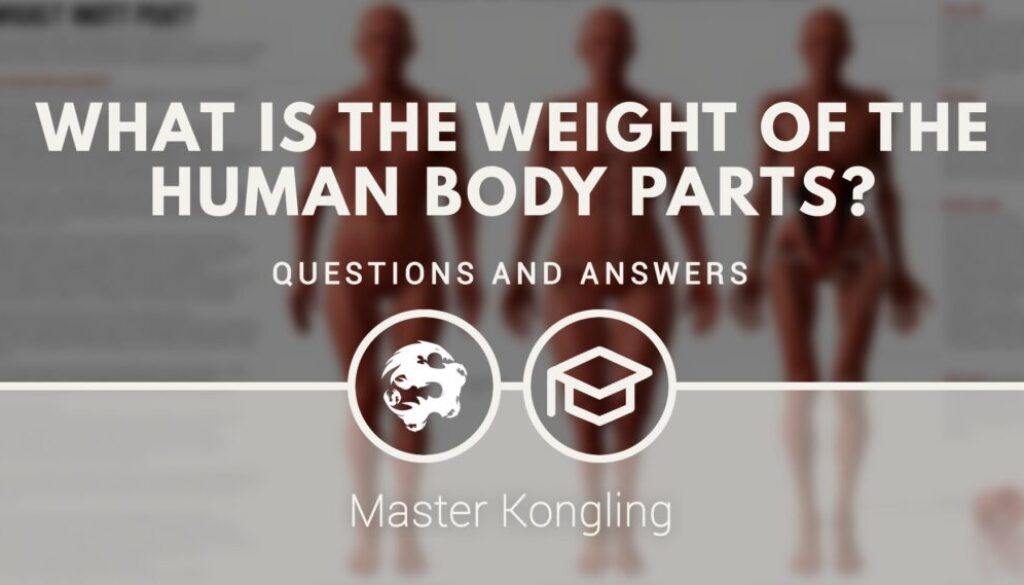What is the weight of the human body parts?
At the base of body manipulation
In martial arts terms, one of the most important pieces of knowledge in relation to the human anatomy is the percentual division of the weight of its various compositive elements (and groups of elements).
Note – This article has been asked by one of our Core Course practitioners on Patreon (see how to attend our home study classes here Learn Kung Fu online: a beginner-to-expert course).
This type of information becomes precious when we have to manipulate our opponent:
- On the ground
- Executing a throw
- Disrupting his / her balance
- Channeling his / her inertia
- …
What influences the weight of the components of the human body
Before entering in details, it must be said that the weight and the percentual weight of the human body parts can vary depending on several factors, including:
- Age – Generally, younger individuals have less muscle mass and more bone tissue compared to adults, while older adults might have less muscle and more fat tissue
- Sex – Women tend to have a higher percentage of body fat than men and their breasts can contribute (on average) to around 3.5% of their total body fat weight
- Body size – Taller individuals might have larger organs but a similar percentage distribution compared to shorter individuals
- Body composition – Each one’s muscles, bones and fat have different densities, impacting their contribution to overall weight
A note by Master Kongling – What we are trying to say is that providing a single “one size fits all” answer isn’t possible. However, the ones we are going to share are general ranges enough precise to base our tactical choices.
How the body’s weight is divided
Let’s start considering the larger body parts:
- 40-50% of the weight is occupied by the upper part of the body
- 50-60% of the weight is occupied by the lower part of the body
About the groups:
- 8-12% of the weight is occupied by the head
- 45-55% of the weight is occupied by the torso (chest and abdomen)
- 5-6% of the weight is occupied by the full arm
- 16-19% of the weight is occupied by the full leg
- 2.52% of the weight is occupied by the forearm plus the hand
- 6.18% of the weight is occupied by the calf and foot
Entering more in detail we can say that:
- 20-25% of the weight is occupied by the chest
- 25-30% of the weight is occupied by the abdomen
- 5-10% of the weight is occupied by the pelvis
- 3.25% of the weight is occupied by the upper part of the arm
- 1.87% of the weight is occupied by the forearm (hand excluded)
- 0.65% of the weight is occupied by the hand
- 10.5% of the weight is occupied by the thigh
- 4.75% of the weight is occupied by the calf
- 1.43% of the weight is occupied by the foot
A note by Master Kongling – Again: let’s take these numbers with a pinch of salt, the percentages are only indicative. Our martial objective is not absolute mathematical-scientific precision, rather we need to have a general idea to achieve our practical fighting purposes.
In-depth video courses
- Body manipulation for combat – How to exploit the body mechanics common to any human being
- How to use feints in combat – The art of real-time deception for high-level preparation
- Basic 6 Dragons Kung Fu Exercises – The basic preparation to develop real martial skills
- Structures for combat: liquid, solid, fluid – The secrets of body tension management for martial arts
- Muscle chain for martial arts: how to – Our methods to connect / use the power of the entire body
- Static and dynamic balance: how to – Develop the capability that distinguishes a beginner from an expert fighter
In-depth articles
- Kung Fu: the parts of the body to condition – What are the body elements to improve and the order
- Martial arts’ body mechanics [MINI-GUIDE] – A free guide to the most important mechanics
Questions
Reply in the comments and share your experience:
- What is the weight percentage that you were not expecting?
Author: Master Kongling
Founder of 6 Dragons Kung Fu.How to master 6 Dragons Kung Fu?
Are you searching for:
- Daily training exercises?
- Synthetic theory and concepts?
- A step by step path from white to black belt?
- A path (clear, consequential and gradual) designed to build real martial skills?
- A direct contact with Master Kongling?
Go to our Patreon page and choose a training plan: starting from the Practitioner level, you will gain access to all this and much more.
Inside each Premium Lesson, you will receive the same teaching (practices, tips, concepts, small secrets and corrections) reserved to the live students of Master Kongling.
Important - Once a certain number of registrations are reached, no other participants can be accepted. For more information write to: [email protected].










January 29, 2024 @ 3:01 am
Is this related to unbalancing?
February 3, 2024 @ 4:23 am
Yes but not only 😉